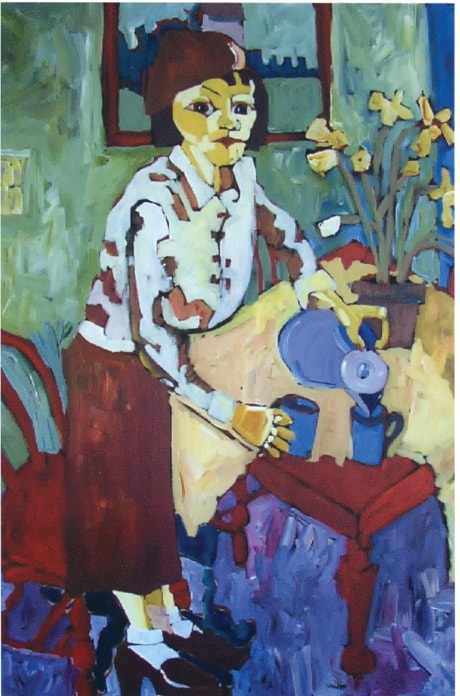There was hardly a memorable moment from Vivian Bennett’s 1950s childhood that didn’t unfold in her mom’s tight little kitchen.
From boisterous mealtimes, when she would cram with her parents and six siblings around the kitchen table, to evenings when she would get a home-perm for school pictures while seated on a chair near the sink, Bennett said, “The kitchen was always the hub of all life that was going on.”
Most idle and important conversations took place around the kitchen table, all birthdays were celebrated there, and various guests and travelling salesmen were invited in for coffee or dinner.
“I remember coming home from school and my mother would be ironing clothes off the clothes line, and there would be this wonderful outdoors smell, and she’d have coffee percolating, and the oven would be on . . .” Bennett pauses, as if savouring the memories.
With such strong and colourful recollections of her mom’s kitchen, it’s little wonder the Stettler-area artist has drawn on kitchens for her latest collection of paintings, Kitchen Talk, which will be exhibited from May 2 to June 21 at the new Red Deer Museum and Art Gallery outlet at the Parkland Mall.
The mall is the MAG’s temporary public space until renovations on the existing museum building are completed in January.
Bennett has painted 21 views of farmhouse kitchens, from 1900 to the present, in her favorite medium — acrylic paints, which dry almost as quickly as the artist can dab vibrant, complementary hues onto canvas.
She started the series about three years ago when she first persuaded some friends and community actors to don garb from various eras and act out scenarios in various Central Alberta kitchens.
The artist took dozens of photographs of her friends in different situations — gossiping at the kitchen sink, folding laundry, nervously awaiting garden club guests — then she picked out the compositions she liked best and used them as references for her paintings.
Her resulting artworks, while expressionistic rather than realistic, have a ring of truth about them, from her subject’s natural body language, to the juxtaposition of eclectic kitchen clutter.
“ All of my pictures tell a story,” said Bennett, who has frequently been inspired to make art about the changing role of women.
She previously painted prostitutes in a bordello. Bennett said she was bothered that most people walk past hookers without really seeing them.
“With a lot of these women, something gawd awful happened to them when they were young, they ran off and turned to prostitution to survive.”
When she painted her ‘prostitutes’ — again from photos of posing friends — she had them wearing masks, symbolizing that society doesn’t recognize them.
Bennett grew up in Edmonton in a liberal-minded family that, none-the-less, had some conventional ideas about how a young woman should live. “There was no question that a girl grew up to get married and have children.”
Bennett was not encouraged to pursue art, but to get an education degree so she could support her family if anything happened to her husband. Her mother had a personal reason for insisting on this, since Bennett’s father died when Bennett was 12 and her mother had to struggle to get back into the workforce.
Bennett, who is now 60, did get married. She also raised a daughter while working as a window display designer in Calgary and a real estate agent in Toronto.
She later divorced and moved near relatives in the Buffalo Lake area, after her daughter was grown.
Her passion for painting was reignited a decade ago when she and her second husband took a Glenda Beaver watercolour workshop together.
Since then, Bennett has never run short of subject material — from her ancestors’ colourful lives and loves in Holland, to Kitchen Talk, which illustrates both everyday and poignant moments — such as a family rejoicing in the return of a son from the Second World War.
Bennett points out that the soldier depicted in her painting Johnny is Home from the War is trying his best to join in his relatives’ celebration, as if six years of experiencing daily horrors in Europe could vanish without a trace. “Of course, he’s supposed to forget. That was what was expected.”
While some paintings feature men, they are generally about women.
“Our generation of women have been through a lot,” explained Bennett — from liberation from menial chores to the recent stresses of trying to be a perfect mom and career woman.
As a teenager, Bennett remembers being paid less than the male staff she trained while working in a department store. “I asked my boss why was I training boys that made more money than me? He said, ‘Well they have to pay for you on dates, don’t they?’ And that was it.
“I was always interested in why can’t I be equal?”
lmichelin@www.reddeeradvocate.com
